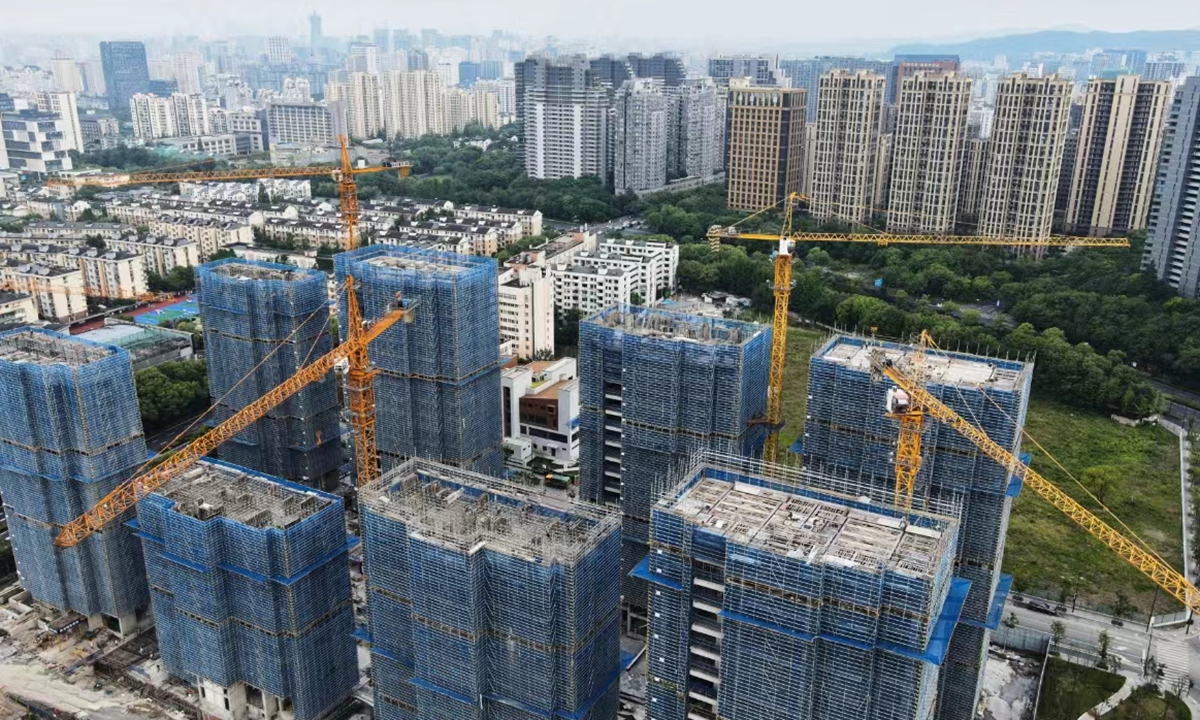
A view of a residential property project under construction in Hangzhou, East China’s Zhejiang Province on May 9, 2024. The city announced the same day that it will lift all home purchase restrictions, making it among the first Chinese cities to completely abolish purchase restrictions amid a nationwide effort to shore up the real estate market. Photo: VCG
Since a series of economic stimulus policies began taking effect in late September, this year’s “Silver October” real estate transactions outpaced those of “Golden September” – the first time this has happened since 2007.
Analysts said on Monday that China’s property market development trend is quietly shifting, with continuous growth in home sales anticipated in the final months of the year.
September and October are traditionally two peak transaction months for homes, widely known in the country as the “Golden September, Silver October” period.
In recent years, however, this season was relatively quiet regarding property transactions – but this year stands out.
In October, the real estate market activity improved, with several indicators showing year-on-year growth after a prolonged period of declines, latest data from Ministry of Housing and Urban-Rural Development showed.
Real estate transactions in China’s first-tier cities – Beijing, Shanghai, Guangzhou, and Shenzhen – showed marked growth, with online new home sales up 14.1 percent year-on-year and second-hand home sales rising by 47.3 percent, the data showed.
In October, Beijing saw 17,000 online second-hand home transactions – a 19-month high – while new home sales increased by 50.1 percent month-on-month, data from Beijing Municipal Commission of Housing and Urban-Rural Development showed.
Since November, Beijing’s second-hand home sales have maintained the recovery momentum from October, remaining at relatively high levels, China Securities Journal reported on Monday.
According to data from Shanghai’s real estate transaction website, the city’s total transaction volume for second-hand homes (including residential, commercial, office spaces, and parking spots) reached 21,922 units from October 1 to 28. Meanwhile, the new home market saw a nearly 40 percent month-on-month increase in transactions.
The real estate market sentiment in other major Chinese cities has also witnessed some improvement. For instance, the new home market in Nanjing city saw a transaction volume of 401,200 square meters in October, marking an 8.77 percent month-over-month increase.
The pent-up housing demand from the past three years is being released, market analysts said. At the same time, intermarket transmission effects have strengthened, with increased activity in the second-hand housing market which helps boost new home sales too.
The positive impact of the government’s economic stimulus policies is being actively felt, continuing to lower home-buying costs and accelerate buyer enthusiasm, a report from Shanghai-based E-house China R&D Institute noted.
The implementation of the government’s incremental pro-growth policies is expected to further stimulate the housing market in the fourth quarter, Yan Yuejin, research director at the institute, told the Global Times on Monday.
Real estate market trading momentum is expected to continue, with new home prices estimated to remain largely stable. It is anticipated that by 2025, the real estate market in major Chinese cities will further recover, with transaction volumes staying strong, Yan predicted.
On October 17, the Ministry of Housing and Urban-Rural Development, along with four other government departments, held a press conference to announce new policy measures to stimulate property sales, which included increasing the credit limit for “whitelist” housing projects to 4 trillion yuan ($557 billion).
“Stimulated by a series of policies, China's real estate market has started to bottom out after three years of adjustment,” Minister of Housing and Urban-Rural Development Ni Hong said at the conference.
Global Times




